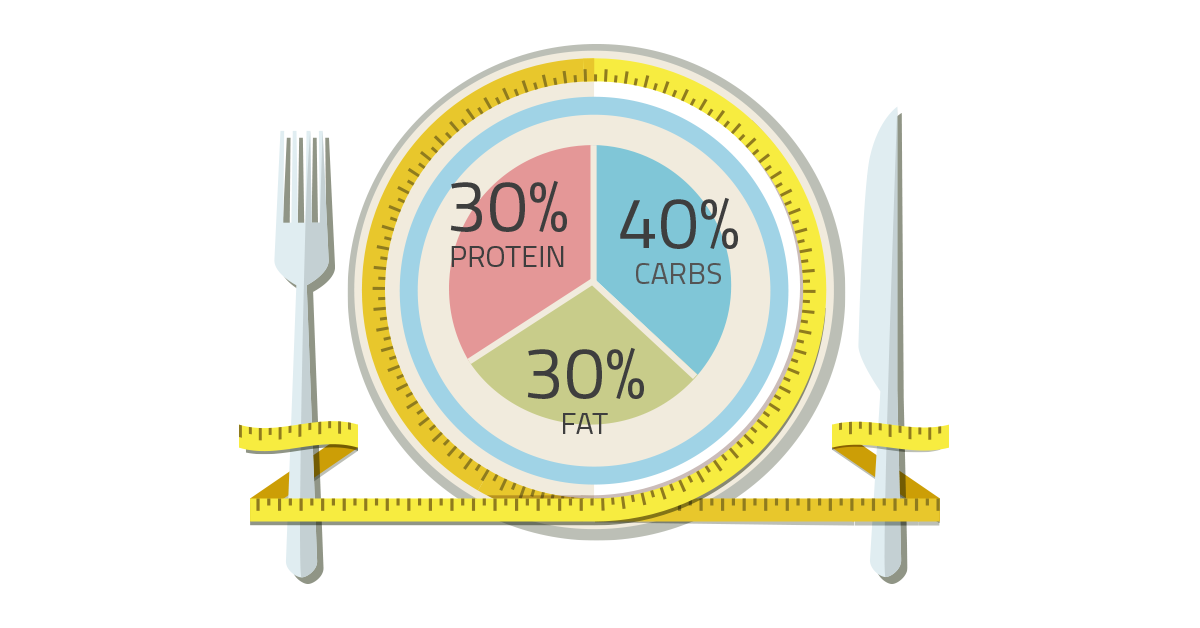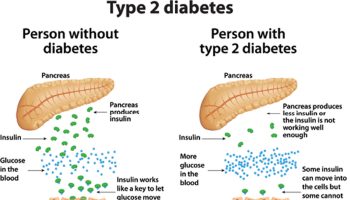
The Zone Diet
The Zone Diet is created by Dr. Barry Sears based on his Zone book to control diet-induced inflammation for a lifetime. The Zone diet is designed so that a person’s daily calorie consumption is comprised of 40 percent carbohydrates, 30 percent protein, and 30 percent fat specifically advocates sparing use of grains and starches 1. More importantly, the precise 0.75 protein to carbohydrate ratio (3 gram protein for every 4 gram carbohydrate) is required with each meal and is promoted to reduce the insulin to glucagon ratio, which purportedly affects eicosanoid metabolism and ultimately produces a cascade of biological events leading to a reduction in chronic disease risk, enhanced immunity, maximal physical and mental performance, increased longevity and permanent weight loss. According to the Zone Diet doctrine, every meal must conform to this 0.75 Protein : Carbohydrate in order to realize the purported health benefits 2. While fat makes up the remaining 30% of total energy. This program typically consisted of an active weight loss-phase in which the daily caloric intake was reduced to 1500 for males and 1200 calories for females, followed by a weight maintenance phase. The recommended macronutrient intake during both phases was 40% carbohydrates, 30% protein and 30% fats. Thirty minutes of exercise on most days of the week was encouraged. Participants were typically offered meal planning and nutritional counseling from a dietitian and group support. Other cointerventions include prepared foods to aid with adherence.
However, there is presently little scientific support for the connections made between the Zone diet, endocrinology and eicosanoid metabolism 3. In fact, a review of the literature suggests that there are scientific contradictions in the Zone Diet hypothesis that cast unquestionable doubt on its potential efficacy.
The underlying dietary principle based on the glycemic index (GI) of foods, specifically the Zone diet allows carbohydrate consumption as long as they have a low glycemic index (GI). The glycemic index (GI) is a measure of the blood glucose response to intake of a particular carbohydrate 4. The higher the peak in postprandial blood glucose levels, the higher the GI value. The glycemic load (GL) is the product of dietary GI and total dietary carbohydrate, providing a useful measure of the total glycemic effect 5. Table 1 shows a list of common foods and their associated GI and GL. A high-GI diet has been proposed to increase hunger and elevate free fatty acid levels, leading to an increased risk of obesity, diabetes, and CVD 6. Several in vitro experiments indicate that elevated postprandial blood glucose levels cause oxidative stress, leading to endothelial damage and activation of coagulation 7.
Table 1. Glycemic Index and Glycemic Loads of Various Foods 6
| Food | Glycemic Index | Glycemic Load |
|---|---|---|
| Glucose | 100 | — |
| Cornflakes | 92 | 24 |
| Baked potato | 85 | 26 |
| Instant rice | 75 | 28 |
| White bread | 70 | 10 |
| Coca-cola | 63 | 16 |
| Wheat bread | 52 | 10 |
| Carrot | 47 | 3 |
| Spaghetti | 41 | 20 |
| Apple | 40 | 6 |
| Lentil beans | 29 | 5 |
| Peanuts | 13 | 1 |
On the Zone diet, you get 3 meals and 2 snacks a day. Each is a mix of low-fat protein, like skinless chicken, turkey, or fish; carbs (mostly fruits and veggies); and a small amount of “good” fat, like olive oil, almonds, and avocado.
Here is what a Zone Diet is all about:
- Every meal on the Zone has the same proportions: 30% protein, 30% fat, and 40% carbohydrate. You need to stick to the 30% protein, 30% fat, and 40% carbs formula at every meal and snack. You can’t pile on the protein at lunch and then have all carbs for dinner.
- And calories do count on the Zone diet. Women get about 1,200 calories a day. For men, it’s 1,500.
- If you have high blood pressure or heart disease and were told to watch your salt, The Zone Diet’s emphasis on fresh ingredients and the shunning of prepared foods will likely fit well into your diet.
- The Zone Diet also has fitness recommendations that closely follow those of the American Heart Association.
The precise 0.75 protein to carbohydrate ratio required by the Zone Diet with each meal is promoted to reduce the insulin to glucagon ratio, which purportedly affects eicosanoid metabolism and ultimately produces a cascade of biological events leading to a reduction in chronic disease risk, enhanced immunity, maximal physical and mental performance, increased longevity and permanent weight loss. No food is completely banned, but if you’re a carb-lover, you may find getting used to the Zone plan challenging. It encourages you to think of bread, pasta, grains, and other starches as condiments rather than as main or even side dishes.
Veggies and fruits that are relatively high in sugar — like corn, carrots, bananas, and raisins — are on the “unfavorable” list. Fatty red meat and egg yolks fall into the Zone’s “bad fats” column.
What that looks like on the plate is a palm-sized portion of protein, two-thirds of the plate filled with nonstarchy fruits and vegetables, and a dash of monounsaturated fat like olive oil or slivered almonds.
Zone Diet vs Atkins Diet vs LEARN Diet vs Ornish Diet for Weight Loss
In a 2007 study 8, where researchers randomly assigned 311 individuals to four groups: one group was assigned the high-fat, high-protein and low-carbohydrate (Atkins diet); the second was assigned Ornish’s very low-fat vegetarian diet, which requires consuming fewer than 10 percent of calories from fat; the third was assigned the Zone diet, which aims for a 40/30/30 percent distribution of carbohydrate, protein and fat (macronutrient balance); and the fourth was assigned the high-carbohydrate, low–saturated fat LEARN (for: lifestyle, exercise, attitudes, relationships, nutrition) diet. Participants were randomly assigned to follow the Atkins (n = 77), Zone (n = 79), LEARN (n = 79), or Ornish (n = 76) diets and received weekly instruction for 2 months, then an additional 10-month follow-up. Weight loss at 12 months was the primary outcome. Secondary outcomes included lipid profile (low-density lipoprotein, high-density lipoprotein, and non–high-density lipoprotein cholesterol, and triglyceride levels), percentage of body fat, waist-hip ratio, fasting insulin and glucose levels, and blood pressure. Outcomes were assessed at months 0, 2, 6, and 12. The participants all had trouble adhering to their regimens, but all lost about the same statistically significant amounts of weight, and when compared head to head, the Atkins dieters saw greater improvements in blood pressure and HDL cholesterol than the Ornish dieters did.
Results 8: Weight loss was greater for women in the Atkins diet group compared with the other diet groups at 12 months, and mean 12-month weight loss was significantly different between the Atkins and Zone diets. Mean 12-month weight loss was as follows:
- Atkins, −4.7 kg ( −6.3 to −3.1 kg),
- Zone, −1.6 kg (−2.8 to −0.4 kg),
- LEARN, −2.6 kg (−3.8 to −1.3 kg), and
- Ornish, −2.2 kg (−3.6 to −0.8 kg).
- Weight loss was not statistically different among the Zone, LEARN, and Ornish groups.
- At 12 months, secondary outcomes for the Atkins group were comparable with or more favorable than the other diet groups.
Conclusions 8: In this study, premenopausal overweight and obese women assigned to follow the Atkins diet, which had the lowest carbohydrate intake, lost more weight and experienced more favorable overall metabolic effects at 12 months than women assigned to follow the Zone, Ornish, or LEARN diets. Average weight loss across all four groups ranged from 3.5 to 10.4 pounds. The authors note that “even modest reductions in excess weight have clinically significant effects on risk factors such as triglycerides and blood pressure.” While questions remain about long-term effects and mechanisms, a low-carbohydrate, high-protein, high-fat diet may be considered a feasible alternative recommendation for weight loss.
In another study published in the Journal of American Medical Association 9, where a total of 160 participants were randomly assigned to either Atkins (carbohydrate restriction), Zone , Weight Watchers (calorie restriction), or Ornish (fat restriction) diet groups. After 12 months of maximum effort, the mean weight loss 9 for all 4 diets resulted in modest statistically significant weight loss, with no statistically significant differences between diets. In each diet group, approximately 25% of the initial participants sustained a 1-year weight loss of more than 5% of initial body weight and approximately 10% of participants lost more than 10% of body weight. Weight reductions were highly associated with waist size reductions for all diets, with no significant difference between diets. In women, mean body weight decreased by 5.1 kg (2.5% change from baseline) and waist size by 4.5 cm, whereas in men body weight decreased by 6.4 kg (3.1% change from baseline) and waist size by 3.1 (5.8) cm at 1 year. Participants on the Atkins Diet which had the lowest carbohydrate intake, lost more weight at 12 months than participants assigned to follow the Zone diet, and had experienced comparable or more favorable metabolic effects than those assigned to the Zone, Weight Watchers or Ornish diets.
Each diet 9 significantly reduced the low-density lipoprotein/high-density lipoprotein (HDL) cholesterol ratio by approximately 10%, with no significant effects on blood pressure or glucose at 1 year. Each popular diet modestly reduced body weight and several cardiac risk factors at 1 year. The participants all had trouble adhering to their regimens, although increased adherence was associated with greater weight loss and cardiac risk factor reductions for each diet group. While questions remain about long-term effects and mechanisms, a low-carbohydrate, high-protein, high-fat diet may be considered a feasible alternative recommendation for weight loss.
Conclusion
There is currently no specific research to prove that eating a certain ratio of protein, carbs, and fats (food proportioning) or certain food combination is going to rev up your metabolism and increase weight loss 10. But it is a proven fact that eating a calorie-restricted diet, like the one such as The Zone Diet, can help you lose weight.
You are likely to do best in The Zone if you love to pick out and prepare fresh vegetables and lean protein. But it will be a struggle if you love your white flour carbs and sweets. And it may be tough to stay in The Zone if you prefer to eat out a lot.
References- ZonePerfect Nutrition Program (2004) http://www.zoneperfect.com/site/content/guide_02_ZoneDiet.asp
- Sears B. “The Zone.” New York Harper Collins, 1995
- J Am Coll Nutr. 2003 Feb;22(1):9-17. The Zone Diet phenomenon: a closer look at the science behind the claims. https://www.ncbi.nlm.nih.gov/pubmed/12569110
- D.J.A. Jenkins, D.M. Thomas, S. Wolever, et al. Glycemic index of food: a physiological basis for carbohydrate exchange. Am J Clin Nutr, 34 (1981), pp. 362-366
- D.J.A. Jenkins, C.W.C. Kendall, L.S.A. Augustin, et al. Glycemic index: overview of implications in health and disease. Am J Clin Nutr, 76 (2002), pp. 266S-273S
- K. Foster-Powell, S.H.A. Holt, J.C. Brand-Miller. International table of glycemic index and glycemic load values: 2002. Am J Clin Nutr, 76 (2002), pp. 5-56
- P.J. Lefebvre, A.J. Scheen. The postprandial state and risk of cardiovascular disease. Diabet Med, 15 (1998), pp. S63-S68
- JAMA. 2007 Mar 7;297(9):969-77. Comparison of the Atkins, Zone, Ornish, and LEARN diets for change in weight and related risk factors among overweight premenopausal women: the A TO Z Weight Loss Study: a randomized trial. https://www.ncbi.nlm.nih.gov/pubmed/17341711
- Dansinger ML, Gleason JA, Griffith JL, Selker HP, Schaefer EJ. Comparison of the Atkins, Ornish, Weight Watchers, and Zone diets for weight loss and heart disease risk reduction: a randomized trial. JAMA. 2005;293:43-53. http://jamanetwork.com/journals/jama/fullarticle/200094
- Annual Review of Public Health Vol. 26:61-88 (Volume publication date 21 April 2005). COMPETING DIETARY CLAIMS FOR WEIGHT LOSS: Finding the Forest Through Truculent Trees. https://doi.org/10.1146/annurev.publhealth.26.021304.144415





